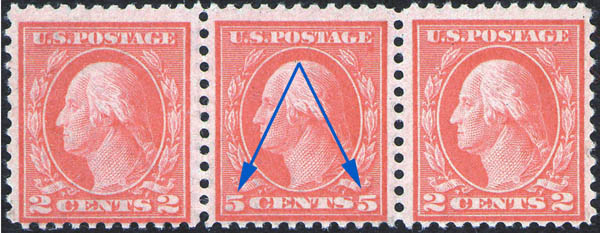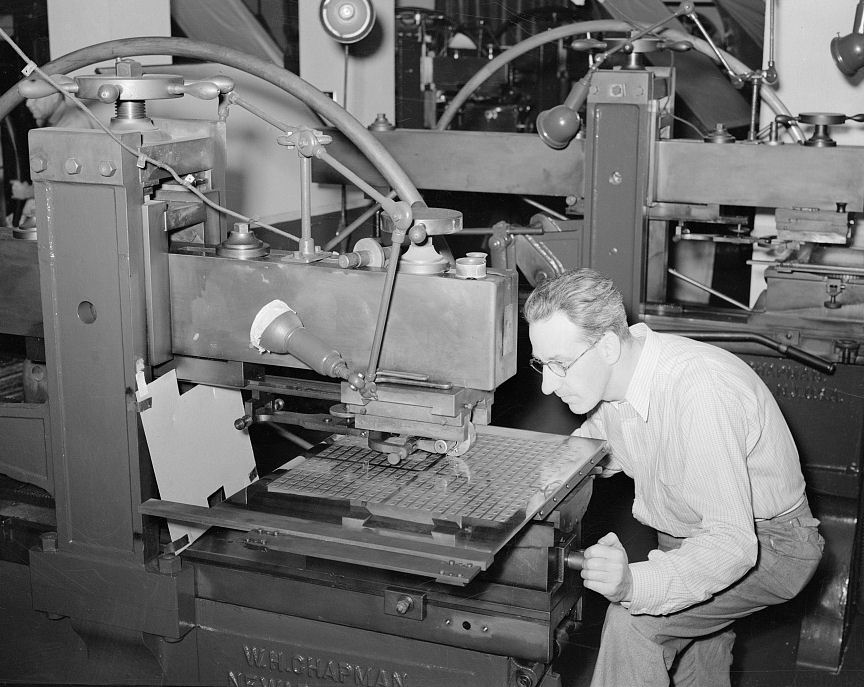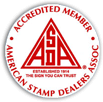back to
5¢ Washington Printing Error (#467 and #505)
In 1917, an unusual and unprecedented error occurred in U.S. stamp printing—a 5¢ Washington stamp appeared within sheets of 2¢ Washington stamps, printed in the same color as the 2¢ denomination. This mistake baffled postal workers and collectors alike, as it was not merely a color error but a misplacement of a denomination within a sheet. Here’s how it happened.
.

5¢ Error flanked on both sides by correct 2¢ Washington issues
#467 - 5¢ Washington - carmine error, perf. 10
#505 - 5¢ Washington - rose error, perf. 11
The Discovery of the Error
In April 1917, a postmaster in a small Virginia post office opened a fresh pad of 2¢ Washington sheets. To his surprise, he found 5¢ Washington stamps within the 2¢ sheets of the identical design and color. The correct 5¢ Washington stamp was supposed to be blue! Frustrated, he quickly returned the sheets to the Postmaster General, complaining that he "already had enough trouble keeping his accounts straight" without having to worry about mixed denominations on the same sheet.
Though this mistake might be considered a color error, it is more accurately classified as a printing error. The sheet was printed in the intended color, but the mistake occurred during the creation of the printing plate rather than during the actual printing process.
How Did the Error Happen?
To understand this error, it helps to know how printing plates were made. The stamp design was first engraved on a steel plate and submitted for approval. Once approved, the engraving was transferred to a steel cylinder, known as a transfer roll. From this roll, individual impressions were placed onto a large steel printing plate, which would serve as the master plate for printing stamps.
Before printing, the plate was carefully inspected for defects. If a defect was found, the design was burnished out, and the transfer roll was used to create a new impression in its place. Proof sheets were then printed and inspected. Once no errors were found, the steel plate was hardened and used for printing.

A transfer roll is used to copy the engraved image to the printing plate
The plate for the 2¢ stamp contained 400 stamp impressions, which were later divided into panes of 100 stamps. During inspection, three defective stamp images were discovered on plate number 7942, requiring correction. At the time, the Bureau of Engraving and Printing was overwhelmed with wartime production demands, leading to staffing shortages and increased pressure on workers. Under these conditions, the technician responsible for fixing the defects mistakenly used the transfer roll for the 5¢ Washington stamp instead of the 2¢ design. Considering that a "5" resembles a reversed "2," it is easy to understand how an overworked worker made this mistake.

The siderograpger transfers engraved images from the transfer roll to the printing plate
On the full printing plate of 400 stamps, three defective impressions were "corrected"—two in the upper left pane and one in the lower right pane. Since the Bureau was under immense pressure to meet printing deadlines, the plate was not inspected again before being sent to press. The resulting sheets, containing the errors, were printed, perforated, and distributed to post offices.
Perforation Variations and Rarity
At the time, the Post Office was experimenting with perforations to determine the optimal gauge that would allow for easy separation while maintaining sheet integrity. The standard had recently changed to gauge 11, and most perforating machines had been adjusted accordingly. However, at least one machine remained set to the older gauge 10. As a result, most sheets from this plate were perforated gauge 11, while a small number were perforated gauge 10. This difference led to two separate catalog listings: the perf 10 version is #467, while the perf 11 version is #505.
Additionally, a very small number of sheets were left imperforate—a common practice at the time. The imperforate 5¢ error stamp is one of the great rarities of the Washington-Franklin series.
The Post Office’s Response
The error was first discovered at a small Virginia post office in late April 1917. The local postmaster promptly reported it to the Post Office Department, complaining about the mixed denominations. The Post Office reacted quickly, instructing postmasters nationwide to inspect their 2¢ stamp sheets and return any containing the 5¢ error. Additionally, postmasters were told to replace any 5¢ error stamps returned by customers with correct 2¢ stamps.
All returned error sheets and the defective printing plate were destroyed. However, since identifying the error required careful inspection of full sheets, many error sheets went unnoticed and reached collectors. Today, this error is most commonly found attached to 2¢ stamps, confirming that the 5¢ impressions were printed in sheets of 2¢ stamps using the same red color.
A Unique Error in U.S. Philately
This type of mistake is unique in U.S. postage stamp history—the only known instance where a stamp of one denomination was accidentally printed within a sheet of another denomination and went undetected by quality control. Today, the 5¢ Washington error stamps remain highly sought after by collectors as a rare and fascinating example of an overlooked printing blunder that became a piece of philatelic history.

